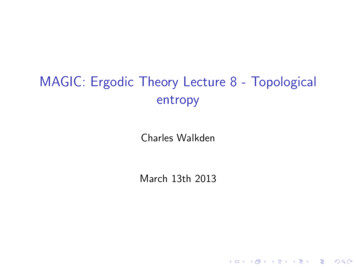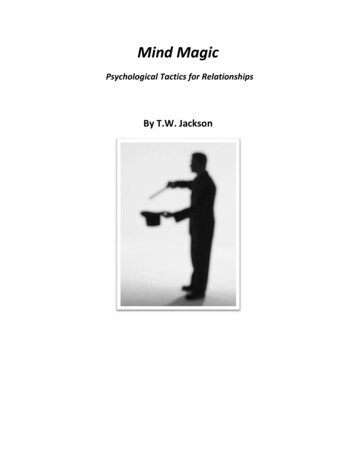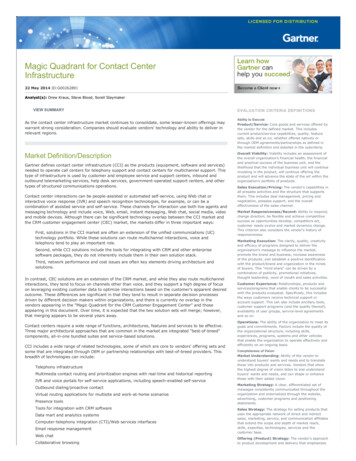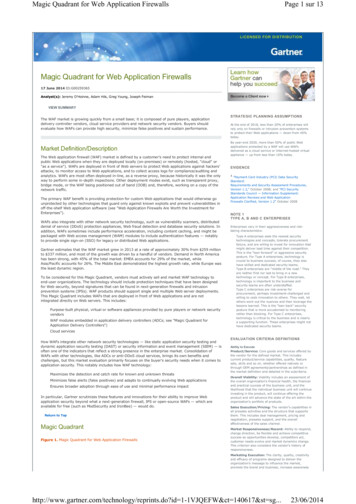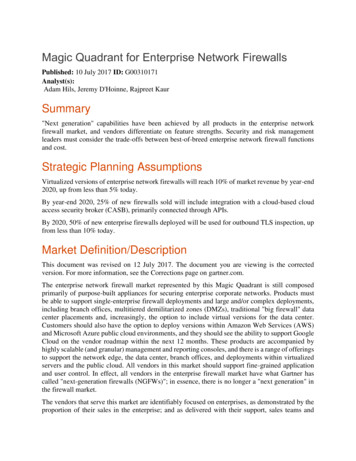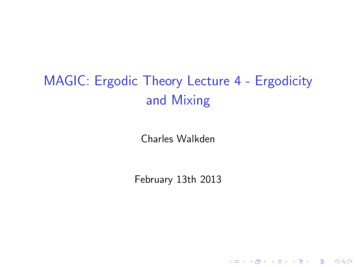
Transcription
MAGIC: Ergodic Theory Lecture 4 - Ergodicityand MixingCharles WalkdenFebruary 13th 2013
Let T be a measurable transformation of the probability space(X , B, µ). Recall that T is a measure preserving transformation(mpt) if, for all B B, we have µ(T 1 B) µ(B).
Let T be a measurable transformation of the probability space(X , B, µ). Recall that T is a measure preserving transformation(mpt) if, for all B B, we have µ(T 1 B) µ(B).In this lecture we define ergodicity.
Let T be a measurable transformation of the probability space(X , B, µ). Recall that T is a measure preserving transformation(mpt) if, for all B B, we have µ(T 1 B) µ(B).In this lecture we define ergodicity.We will also briefly discuss mixing properties that imply ergodicity.
Let T be a measurable transformation of the probability space(X , B, µ). Recall that T is a measure preserving transformation(mpt) if, for all B B, we have µ(T 1 B) µ(B).In this lecture we define ergodicity.We will also briefly discuss mixing properties that imply ergodicity.Motivation: Birkhoff’s Ergodic TheoremSuppose:IT is an ergodic measure-preserving transformation of aprobability space (X , B, µ),If L1 (X , B, µ).
Let T be a measurable transformation of the probability space(X , B, µ). Recall that T is a measure preserving transformation(mpt) if, for all B B, we have µ(T 1 B) µ(B).In this lecture we define ergodicity.We will also briefly discuss mixing properties that imply ergodicity.Motivation: Birkhoff’s Ergodic TheoremSuppose:IT is an ergodic measure-preserving transformation of aprobability space (X , B, µ),If L1 (X , B, µ).Thenn 11Xf (T j x) nj 0Zf dµ µ-a.e. x X .
DefinitionA mpt T of a probability space (X , B, µ) is ergodic (or µ is anergodic measure for T ) if
DefinitionA mpt T of a probability space (X , B, µ) is ergodic (or µ is anergodic measure for T ) ifT 1 B B, B B
DefinitionA mpt T of a probability space (X , B, µ) is ergodic (or µ is anergodic measure for T ) ifT 1 B B, B B µ(B) 0 or 1
DefinitionA mpt T of a probability space (X , B, µ) is ergodic (or µ is anergodic measure for T ) ifT 1 B B, B B µ(B) 0 or 1i.e. the only T -invariant subsets are trivial.
DefinitionA mpt T of a probability space (X , B, µ) is ergodic (or µ is anergodic measure for T ) ifT 1 B B, B B µ(B) 0 or 1i.e. the only T -invariant subsets are trivial.RemarkErgodicity is an indecomposability assumption.
DefinitionA mpt T of a probability space (X , B, µ) is ergodic (or µ is anergodic measure for T ) ifT 1 B B, B B µ(B) 0 or 1i.e. the only T -invariant subsets are trivial.RemarkErgodicity is an indecomposability assumption. Suppose T is notergodic. Then B B with 0 µ(B) 1 such that T 1 B B.
DefinitionA mpt T of a probability space (X , B, µ) is ergodic (or µ is anergodic measure for T ) ifT 1 B B, B B µ(B) 0 or 1i.e. the only T -invariant subsets are trivial.RemarkErgodicity is an indecomposability assumption. Suppose T is notergodic. Then B B with 0 µ(B) 1 such that T 1 B B.T : B B is a mpt of the probaBcbility space B with invariant prob1BkTability measure µ(B)µ( · B).T3
DefinitionA mpt T of a probability space (X , B, µ) is ergodic (or µ is anergodic measure for T ) ifT 1 B B, B B µ(B) 0 or 1i.e. the only T -invariant subsets are trivial.RemarkErgodicity is an indecomposability assumption. Suppose T is notergodic. Then B B with 0 µ(B) 1 such that T 1 B B.T : B B is a mpt of the probaBcbility space B with invariant prob1BkTability measure µ(B)µ( · B).T3T : B c B c is a mpt of the probability space B with invariant probability measure µ(B1 c ) µ( · B c ).
Recall:If A, B X , then the symmetric differenceA 4 B (A\B) (B\A).
Recall:If A, B X , then the symmetric differenceA 4 B (A\B) (B\A).AA BB
Recall:If A, B X , then the symmetric differenceA 4 B (A\B) (B\A).AA BBDefinitionWe say A B a.e. or A B mod 0 if µ(A 4 B) 0.
Recall:If A, B X , then the symmetric differenceA 4 B (A\B) (B\A).AA BBDefinitionWe say A B a.e. or A B mod 0 if µ(A 4 B) 0. Note:A B a.e. µ(A) µ(B).
LemmaT is ergodic if T 1 B B µ-a.e. then µ(B) 0 or 1.
LemmaT is ergodic if T 1 B B µ-a.e. then µ(B) 0 or 1.Proof.In notes. (Philosophy: in measure theory, sets of measure zerodon’t matter.)
LemmaT is ergodic if T 1 B B µ-a.e. then µ(B) 0 or 1.Proof.In notes. (Philosophy: in measure theory, sets of measure zerodon’t matter.)The following gives a useful criterion for ergodicity.
LemmaT is ergodic if T 1 B B µ-a.e. then µ(B) 0 or 1.Proof.In notes. (Philosophy: in measure theory, sets of measure zerodon’t matter.)The following gives a useful criterion for ergodicity.PropositionLet T be a mpt of a probability space (X , B, µ). Then thefollowng are equivalent1. T is ergodic.
LemmaT is ergodic if T 1 B B µ-a.e. then µ(B) 0 or 1.Proof.In notes. (Philosophy: in measure theory, sets of measure zerodon’t matter.)The following gives a useful criterion for ergodicity.PropositionLet T be a mpt of a probability space (X , B, µ). Then thefollowng are equivalent1. T is ergodic.2. “The only T -invariant functions are constant”
LemmaT is ergodic if T 1 B B µ-a.e. then µ(B) 0 or 1.Proof.In notes. (Philosophy: in measure theory, sets of measure zerodon’t matter.)The following gives a useful criterion for ergodicity.PropositionLet T be a mpt of a probability space (X , B, µ). Then thefollowng are equivalent1. T is ergodic.2. “The only T -invariant functions are constant”f L1 (X , B, µ), f T f µ-a.e. f const. µ-a.e.
LemmaT is ergodic if T 1 B B µ-a.e. then µ(B) 0 or 1.Proof.In notes. (Philosophy: in measure theory, sets of measure zerodon’t matter.)The following gives a useful criterion for ergodicity.PropositionLet T be a mpt of a probability space (X , B, µ). Then thefollowng are equivalent1. T is ergodic.2. “The only T -invariant functions are constant”f L1 (X , B, µ), f T f µ-a.e. f const. µ-a.e.Remark: We can replace L1 in 2. by L2 .
Proof: (sketch)
Proof: (sketch)(2 1) Suppose B B is T -invariant: T 1 B B. We want toshow µ(B) 0 or 1. Let f χB .
Proof: (sketch)(2 1) Suppose B B is T -invariant: T 1 B B. We want toshow µ(B) 0 or 1. Let f χB . Thenf T χB T χT 1 B χB f .Hence χB constant µ-a.e.
Proof: (sketch)(2 1) Suppose B B is T -invariant: T 1 B B. We want toshow µ(B) 0 or 1. Let f χB . Thenf T χB T χT 1 B χB f .Hence χB constant µ-a.e.RHence µ(B) χB dµ 0 or 1.
Proof: (sketch)(2 1) Suppose B B is T -invariant: T 1 B B. We want toshow µ(B) 0 or 1. Let f χB . Thenf T χB T χT 1 B χB f .Hence χB constant µ-a.e.RHence µ(B) χB dµ 0 or 1.
Using Fourier Series to prove ergodicity
Using Fourier Series to prove ergodicityLet X R/Z. Fix α R and define the circle rotationTx x α mod 1. We have seen that T preserves Lebesguemeasure µ.
Using Fourier Series to prove ergodicityLet X R/Z. Fix α R and define the circle rotationTx x α mod 1. We have seen that T preserves Lebesguemeasure µ.PropositionT is ergodic w.r.t. Lebesgue measure α / Q.
Using Fourier Series to prove ergodicityLet X R/Z. Fix α R and define the circle rotationTx x α mod 1. We have seen that T preserves Lebesguemeasure µ.PropositionT is ergodic w.r.t. Lebesgue measure α / Q.Proof: Suppose α qp , p, q Z with q 6 0.
Using Fourier Series to prove ergodicityLet X R/Z. Fix α R and define the circle rotationTx x α mod 1. We have seen that T preserves Lebesguemeasure µ.PropositionT is ergodic w.r.t. Lebesgue measure α / Q.Proof: Suppose α qp , p, q Z with q 6 0. Letf (x) exp(2πiqx). Then f is non-constant and pf (Tx) exp 2πiq x exp(2πi(qx p))q exp(2πiqx) f (x)so f is T -invariant. Hence T is not ergodic.
Suppose α / Q.
Suppose α / Q. Let f L2 be T -invariant: f T f a.e.
Suppose α / Q. Let f L2 be T -invariant: f T f a.e.Let f have Fourier series Xn cn e 2πinx
Suppose α / Q. Let f L2 be T -invariant: f T f a.e.Let f have Fourier series Xcn e 2πinxn Then f T has Fourier series Xn cn e2πin(x α) Xn cn e 2πinα e 2πinx .
Suppose α / Q. Let f L2 be T -invariant: f T f a.e.Let f have Fourier series Xcn e 2πinxn Then f T has Fourier series Xn cn e2πin(x α) Xcn e 2πinα e 2πinx .n Comparing Fourier coefficients givescn cn e 2πinα .
Suppose α / Q. Let f L2 be T -invariant: f T f a.e.Let f have Fourier series Xcn e 2πinxn Then f T has Fourier series Xn cn e2πin(x α) Xcn e 2πinα e 2πinx .n Comparing Fourier coefficients givescn cn e 2πinα .If n 6 0, then exp(2πinα) 6 1 (as α irrational). Hence:n 6 0 cn 0. Hence f has Fourier series c0 , i.e. f isconstant a.e.
Recall: The Riemann-Lebesgue Lemma.
Recall: The Riemann-Lebesgue Lemma. If f L2 has FourierPseriescn e 2πinx then cn 0 as n .
Recall: The Riemann-Lebesgue Lemma. If f L2 has FourierPseriescn e 2πinx then cn 0 as n .In higher dimensions this is:
Recall: The Riemann-Lebesgue Lemma. If f L2 has FourierPseriescn e 2πinx then cn 0 as n .In higher dimensions this is: If f L2 has Fourier seriesXcn e 2πihn,xin Zkthen cn 0 as knk .
The doubling mapPropositionThe doubling map Tx 2x mod 1 is ergodic w.r.t. Lebesguemeasure.
The doubling mapPropositionThe doubling map Tx 2x mod 1 is ergodic w.r.t. Lebesguemeasure.Proof Suppose f L2 is T -invariant: f T f a.e.
The doubling mapPropositionThe doubling map Tx 2x mod 1 is ergodic w.r.t. Lebesguemeasure.Proof Suppose f L2 is T -invariant: f T f a.e.Then f T p f a.e. p 0.
The doubling mapPropositionThe doubling map Tx 2x mod 1 is ergodic w.r.t. Lebesguemeasure.Proof Suppose f L2 is T -invariant: f T f a.e.Then f T p f a.e. p 0. Let f have Fourier series Xcn e 2πinx .n
The doubling mapPropositionThe doubling map Tx 2x mod 1 is ergodic w.r.t. Lebesguemeasure.Proof Suppose f L2 is T -invariant: f T f a.e.Then f T p f a.e. p 0. Let f have Fourier series Xcn e 2πinx .n Then f Tphas Fourier series Xn p nxcn e 2πi2.
The doubling mapPropositionThe doubling map Tx 2x mod 1 is ergodic w.r.t. Lebesguemeasure.Proof Suppose f L2 is T -invariant: f T f a.e.Then f T p f a.e. p 0. Let f have Fourier series Xcn e 2πinx .n Then f Tphas Fourier series Xp nxcn e 2πi2.n Comparing Fourier coefficients: c2p n cn n Z, p 0.
The doubling mapPropositionThe doubling map Tx 2x mod 1 is ergodic w.r.t. Lebesguemeasure.Proof Suppose f L2 is T -invariant: f T f a.e.Then f T p f a.e. p 0. Let f have Fourier series Xcn e 2πinx .n Then f Tphas Fourier series Xp nxcn e 2πi2.n Comparing Fourier coefficients: c2p n cn n Z, p 0.Suppose n 6 0. Then 2p n as p . By the RiemannLebesgue lemma: cn c2p n 0. Hence cn 0 n 6 0.Hence f has Fourier series c0 so f is constant a.e. Hence T is
Toral endomorphismsLet X Rk /Zk and A be a k k integer matrix s.t. det A 6 0.Define T : X X by Tx Ax mod 1. We know that T preservesLebesgue measure.
Toral endomorphismsLet X Rk /Zk and A be a k k integer matrix s.t. det A 6 0.Define T : X X by Tx Ax mod 1. We know that T preservesLebesgue measure.PropositionT is ergodic w.r.t. Lebesgue measure A has no roots ofunity as eigenvalues.
Toral endomorphismsLet X Rk /Zk and A be a k k integer matrix s.t. det A 6 0.Define T : X X by Tx Ax mod 1. We know that T preservesLebesgue measure.PropositionT is ergodic w.r.t. Lebesgue measure A has no roots ofunity as eigenvalues.
Using approximation to prove ergodicityLet T be a measure-preserving transformation of a probabilityspace (X , B, µ). Suppose A is an algebra that generates B. Weshow how to prove ergodicity by approximating invariant setsT 1 B B by sets in A.
Using approximation to prove ergodicityLet T be a measure-preserving transformation of a probabilityspace (X , B, µ). Suppose A is an algebra that generates B. Weshow how to prove ergodicity by approximating invariant setsT 1 B B by sets in A.Key Technical LemmaSuppose: (X , B, µ) is a probability space, A an algebra thatgenerates B. Let B B.
Using approximation to prove ergodicityLet T be a measure-preserving transformation of a probabilityspace (X , B, µ). Suppose A is an algebra that generates B. Weshow how to prove ergodicity by approximating invariant setsT 1 B B by sets in A.Key Technical LemmaSuppose: (X , B, µ) is a probability space, A an algebra thatgenerates B. Let B B. Suppose there exists k 0 such thatµ(B)µ(I ) kµ(B I ) I A.
Using approximation to prove ergodicityLet T be a measure-preserving transformation of a probabilityspace (X , B, µ). Suppose A is an algebra that generates B. Weshow how to prove ergodicity by approximating invariant setsT 1 B B by sets in A.Key Technical LemmaSuppose: (X , B, µ) is a probability space, A an algebra thatgenerates B. Let B B. Suppose there exists k 0 such thatµ(B)µ(I ) kµ(B I ) I A.Then µ(B) 0 or 1.
Using approximation to prove ergodicityLet T be a measure-preserving transformation of a probabilityspace (X , B, µ). Suppose A is an algebra that generates B. Weshow how to prove ergodicity by approximating invariant setsT 1 B B by sets in A.Key Technical LemmaSuppose: (X , B, µ) is a probability space, A an algebra thatgenerates B. Let B B. Suppose there exists k 0 such thatµ(B)µ(I ) kµ(B I ) I A.Then µ(B) 0 or 1.Idea: approximate B c by an element A A.
Using approximation to prove ergodicityLet T be a measure-preserving transformation of a probabilityspace (X , B
MAGIC: Ergodic Theory Lecture 4 - Ergodicity and Mixing. Charles Walkden February 13th 2013. Let T be a measurable transformation of the probability space (X;B; ). Recall that T is a measure preserving transformation (mpt) if, for all B 2B, we have (T1B) (B). In this lecture we de ne ergodicity.
